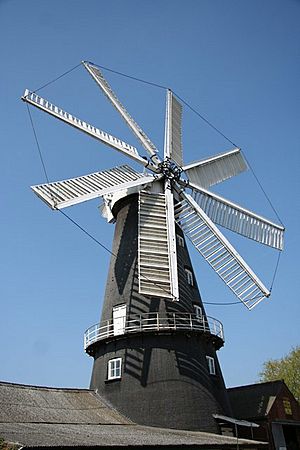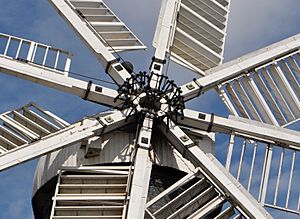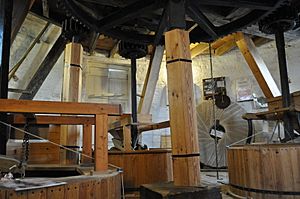Heckington Windmill facts for kids
Quick facts for kids Heckington Windmill |
|
|---|---|

The mill as preserved
|
|
| Origin | |
| Mill name | Heckington Windmill Pocklington's Mill, Heckington |
| Grid reference | TF 146 436 |
| Coordinates | 52°58′37″N 0°17′43″W / 52.977059°N 0.29521°W |
| Operator(s) | Heckington Mill Trust |
| Year built | 1830 |
| Information | |
| Purpose | Corn mill and sawmill |
| Type | Tower mill |
| No. of sails | Eight sails |
| Type of sails | Patent sails |
| Windshaft | Cast iron |
| Winding | Fantail |
| Fantail blades | Eight blades |
| No. of pairs of millstones | Four pairs |
| Type of saw | Circular saw |
Heckington Windmill is a very special building in England. It's the only windmill in the whole United Kingdom that still has eight sails and is standing tall!
This amazing windmill is located in a village called Heckington. You can find Heckington between the towns of Sleaford and Boston in Lincolnshire, England. The mill is very close to the Heckington railway station. Because of this, people in the 1800s sometimes called it the 'Station Mill'. It's also a Grade I listed building, which means it's a very important historical site.
Contents
Building the Windmill
The Heckington Windmill was built in 1830. A man named Michael Hare had it built, and the plans were drawn by a skilled mill builder named Edward Ingledew. Ingledew also built other windmills, like the ones at Wragby and Waltham Windmill.
The windmill's tower is made of red bricks. The outside walls were painted with a black tar-like paint to keep moisture out. When it was first built, it had five sails, similar to the Alford Windmill. These sails were called "patent sails" and were quite large.
The mill has six levels, which are called "floors":
- The ground floor
- The meal floor
- The stone (or stage) floor
- The lower bin floor
- The upper bin floor (also called the hoist floor)
- The dust or cap floor
A Mill's Story
For over 60 years, the five-sailed windmill worked hard. It used three pairs of grinding stones to mill grain. The first owner, Michael Hare, passed away before 1834. His wife, Ann Hare, then married another miller named Sleightholme Nash.
Later, the mill was owned by Joseph Nash, who was Sleightholme Nash's son. Joseph was the last miller to work at the mill before a big accident happened in 1890. A strong tail-wind caused the sails to spin backward. The fantail, which usually keeps the cap facing the wind, had been destroyed by lightning. This meant the cap spun out of control. It blew off the top of the tower, smashing the upper machinery and all five sails. The top of the tower was also damaged. After this, Joseph Nash left the ruined mill.
A New Beginning for the Mill
In 1891, a clever miller named John Pocklington bought the eight-sailed cap and machinery from an old, broken mill called Tuxford's Mill. He bought it for only £72 at an auction! He needed a place to put his new purchase, so he bought the wrecked Heckington Mill.
From 1891 to early 1892, John Pocklington carefully fitted the white, onion-shaped cap from Tuxford's Mill onto the Heckington Mill. This new cap had a fantail to turn it into the wind. The mill started working again and continued for another 54 years!
John Pocklington also added a large circular saw-mill in a shed next to the windmill. This saw was also powered by the wind through shafts. It was used to cut elm wood, often for making coffin boards. John Pocklington was very successful. He was involved in milling, baking, building, sawing, and farming. During this time, and even today, the mill was also known as Pocklington's Mill.
Restoration and Modern Use
After John Pocklington passed away in 1941, the mill stopped working in 1946. It remained still for the next 40 years. In 1953, the local council took over the mill. They started the first restorations to save this important old building from being taken apart.
Later, the Lincolnshire County Council took ownership. In 1986, the mill was finally fully restored and could work again! This restoration included building 192 new "shades" (parts of the sails) and four new sails. The "Friends of Heckington Mill" group helped a lot with this work. The new sails and their cross weighed five tons!
Heckington Windmill is special because it has a very large sail area with its eight sails. It's also in a windy spot. This means it can drive four pairs of millstones even when there's only a light breeze. Other local mills might not be able to work in such light winds. The mill also has a machine to make white flour sometimes.
Today, the Heckington Windmill Trust runs the mill. This trust was started in 1986. In 2014, the Trust bought the buildings and land around the windmill with help from a special grant. These buildings have been restored and now include a visitor centre, a shop, and a bakehouse. The old miller's house is now a tea room and cafe. There's even a small brewery, called the 8 Sail Brewery, in the old saw mill building!
The windmill also has a special wooden frame that holds millstones. This frame can be powered by an oil engine. This means the mill can still grind grain even when there is no wind!
Visiting the Mill
The Heckington Windmill is open for visitors:
- It is open all year on Fridays, Saturdays, and Sundays.
- It has extended opening hours from mid-July to early September for summer holidays.
You can visit their website for more information: www.HeckingtonWindmill.org.uk
Other Eight-Sailed Windmills
Heckington Windmill is the last of its kind in England. There were once about 12 windmills with eight sails in England, including four in Lincolnshire. Some of these included:
- Skirbeck Mill (Tuxford's Mill) in Boston, Lincolnshire. Its machinery and sails were moved to Heckington in 1890.
- Barrington Mill in Holbeach, Lincolnshire.
- Market Rasen Mill in Market Rasen, Lincolnshire.
- Preston Place Mill in Angmering, Sussex.
- Old Buckenham tower windmill in Norfolk. It still stands but now has only four sails after being damaged in 1879.
- Victoria Road tower mill in Diss, Norfolk. It was changed to a four-sailed mill in 1880 and later became a house in 1972.
- Leach's tower mill in Wisbech, Cambridgeshire. This was the tallest eight-sailed mill ever built, with eight storeys. It is now a house.
Many of these other eight-sailed mills were changed to have four sails, turned into homes, taken apart, or are now just ruins.
There are also windmills in the Mediterranean Sea region that seem to have many sails. However, their sails are usually long poles with triangular cloths, not like the shutter-type sails of Heckington Windmill. Some other types of windmills, like post mills in Northern Europe and Finland, also have multiple short sails.
Boyd's Windmill in Rhode Island, USA, is another example of a large windmill with eight sails.
Images for kids
-
Eight-sailed post windmill with short sails on Kizhi island, Lake Onega, Russia




